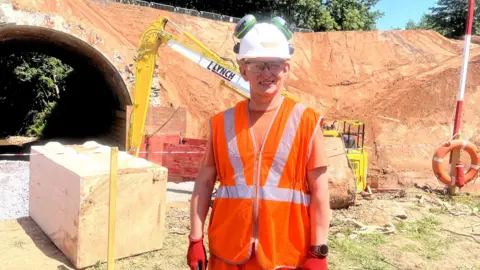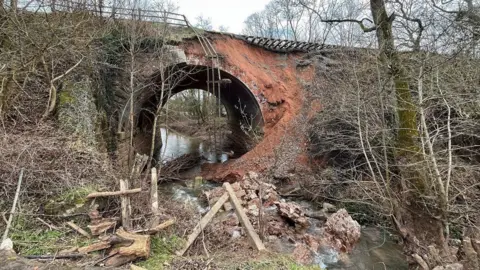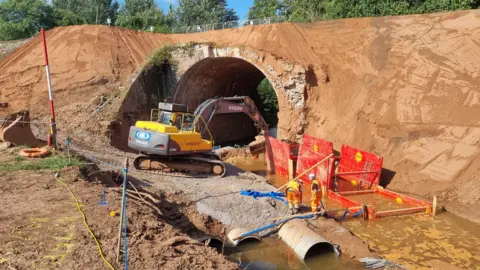How do you repair a heritage railway landslip?
 Severn Valley Railway
Severn Valley RailwayFollowing a storm at the end of January, the Severn Valley Railway (SVR) suffered a major blow - a serious landslip that halted some services and cost tens of thousands of pounds.
The affected area was between the Bridgnorth and Hampton Loade stations, and meant that trains could not operate there.
The railway runs for 16 miles from Kidderminster in Worcestershire to Bridgnorth in Shropshire.
So how do you fix a major issue on a heritage railway line that was built in the 1860s? It's something Antony Bartlam - a structural engineer and project manager at SVR - has been working hard to deal with.
He has been involved with SVR for more than 10 years, and spent the last three overseeing structural works
He described the landslip as a "complete freak accident."

"We had a tree that wasn't on our land, it fell and caused some damage to one of the wing walls on the bridge," he said.
"That allowed water to get behind the wing wall and that then caused the collapse.
"We'd actually inspected that bridge not long beforehand, so we knew it was in good condition."
A lot of paperwork needed to be filled out before any work could actually begin.
The process began with an insurance claim, which required evidence to prove that the slip was an accident.
 Gary Essex
Gary EssexIt was then on to contractors.
"They're very experienced with railway work, they said that it's one of the most complex jobs that they've had to undertake," said Mr Bartlam.
The job needed involvement from Shropshire Council and the Environment Agency before working in the watercourse.
"We've had to have surveys done for animals like otters and crayfish, anything that's in the brook that could be affected by what we're doing."
Earlier this week, the embankment was dug out to allow a new wall to be constructed. Next, they will pour concrete for the new foundation, and the wall will go up.
"That embankment and the wing wall have been there for 160-odd years and nothing has happened to it, and that's why it's such a freak accident," said Mr Bartlam.
 Gary Essex
Gary Essex"We had floods back in 2007 which caused a major problem with the railway... I would probably equate them to that in terms of the damage that it's caused."
He added it would be a "big relief" when the section was open again.
"Bridgnorth has been very cut off, I know retail trade has been affected by the railway not running up there."
Once the work is completed, testing will take place, followed by monitoring for about a month.
"That'll be a little bit of a nervous time to make sure everything's settled in and is working as it should do, but once that's completed then there should be no further issues," said Mr Bartlam.
The railway is due to fully reopen on 25 July. The Flying Scotsman will run on 26 and 27 July - tickets for which sold out in three minutes.
Follow BBC Shropshire on BBC Sounds, Facebook, X and Instagram.
